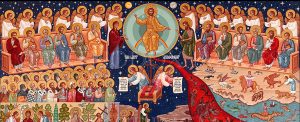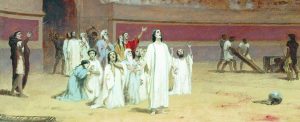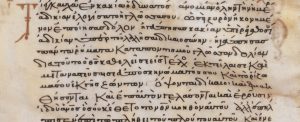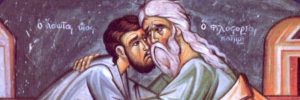I was raised without any religious faith, and became first a modern Evangelical and then an Eastern Orthodox Christian. So while I’ve grown familiar with many eastern Christian liturgical traditions and family customs, western Christian liturgical traditions related to Christmas and Easter are pretty unfamiliar to me. I read Lutheran or Anglican descriptions of their holiday preparations, and it’s fascinating but quite outside my experience.
So I enjoy reading how western liturgical Christians adapt their existing cultural observances when they enter the Orthodox Church. Father Ernesto Obregon, who came to Orthodoxy from the Anglican tradition, describes how his family uses an Advent wreath to build anticipation of the feast of Christ’s Nativity as the Church enters the Advent season which begins November 15. He writes:
Advent is the 40 day period prior to Nativity during which we prepare ourselves for the coming of the Messiah. It is a period of fasting, prayer and participation in the church services and sacraments to help us understand the full meaning of Christ’s coming.
One way to observe Advent and involve the whole family is through the Advent wreath. First purchase a wreath (either decorated or a plain one which can be decorated) or make one out of styrofoam. There should be space enough for seven candles (one for each week of Advent). Between the candles spread evergreen branches or arrange the candles around the wreath between the branches. The colors of the candles are: green, blue, gold, white, red and purple. If it is difficult to obtain candles in these colors, tie colored ribbon around white candles.
As the wreath is assembled know the symbolism of each part. The circle (wreath) is the Christian symbol for God Who is eternal. The evergreen branches symbolize eternal life, the life of God, of which Christ came to make us partakers. The candles represent Christ Who is the light of the world. The color of each candle expresses a specific theme which can be discussed as a family or among fellow Orthodox Christians each week as Advent progresses. One candle is lit each week on Sunday.
First Sunday of Advent
Candle: green (faith)
Symbolism: The first candle reminds us of faith, the faith we have in God that He will keep His promise to send His Son.
Scripture: Isaiah 9:2, 6-7; 40:3-5; 52:7
Theme: God’s promise to send the Messiah.
Second Sunday of Advent
Candle: blue (hope)
Light both candles and review the meaning of the first candle.
Symbolism: The second candle reminds us of the hope we have that Christ will come again this year to bring new joy into our lives.
Scripture: Luke 1:5-31
Theme: Ways in which Christ brings joy to our hearts today and why should a Christian be joyful.
Third Sunday of Advent
Candle: gold (love)
Light all three candles and review the meaning of the first two candles.
Symbolism: Remember the words of St. John, “God so loved the world that He gave His only Son.”
Scripture: St. Luke 1:26-38.
Theme: The life of St. Nicholas who was known for his great generosity in distributing gifts and money to the poor. He preferred to deliver his gifts after dark and in disguise so that no one would know who left them. How can we follow his example by giving gifts to the needy?
Fourth Sunday of Advent
Candle: white (peace)
Always review the meaning of the previous candles as the candles are being lit.
Symbolism: This candle reminds us of the Angel’s message to the shepherds, “Peace on earth, goodwill toward men.”
Scripture: Luke 2:1-18
Theme: Reflect on whether there is someone who has something against us, or if we have something against anyone. Are there relationships that need repairing or people we need to forgive? Forgive and be forgiven.
Fifth Sunday of Advent
Candle: purple (repentance)
Review the meaning of the first four candles.
Symbolism: This candle reminds us of our need to repent before we can meet the coming of Christ. “Repent, for the kingdom of God is at hand.”
Scripture: Mark 1:1-8, 14-15.
Theme: Discuss repentance and then prepare oneself with a thorough self-examination followed by confession and communion.
Sixth Sunday of Advent
Candle: red (Holy Communion)
Symbolism: Christ, Who was born in Bethlehem and Who will come again at the end of time, comes to us now in the great Sacrament of Holy Communion. The reason He was born in Bethlehem was that we might allow Him to come and be born in the manger of our hearts.
Scripture: John 1:1-18 and John 6:52-58.
Theme: Reflect on Holy Communion
Seventh Sunday of Advent
Candle: a specially decorated white candle such as the one used at baptism or during Pascha (Christ)
Begin by lighting all seven candles. Review the meaning of the first six candles.
Symbolism: “For unto us a child is born, unto us a Son is given and His name shall be called Wonderful.”
Scripture: Luke 2:1-7
Theme: The meaning of Christ’s coming.






